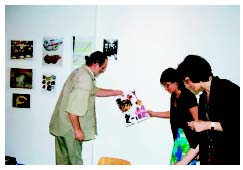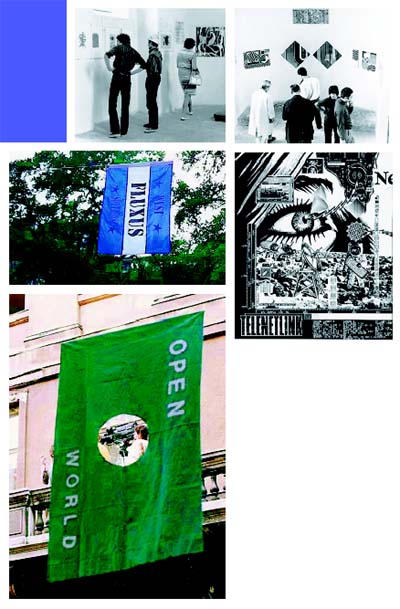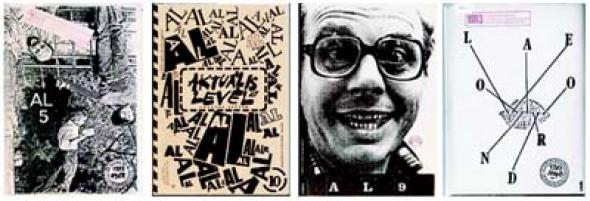Relational history
György Galántai and Julia Klaniczay, the founding members of Budapest’s Artpool Art Research Centre, visited London’s Austrian Cultural Forum this summer. Pauline van Mourik Broekman reports on a public archive institution with a difference
This summer the Austrian Cultural Forum, continuing its recent programme of curatorial devolution, invited duo B+B (Sophie Hope and Sarah Carrington) to put on a series of special events. In the face of imminent EU enlargement and the unforeseeable changes it will no doubt instigate, B+B’s ‘at home’ chose to focus on the many artists and organisations they had encountered during past journeys through Central and Eastern Europe. Two evening events were dedicated to Hungarian organisation Artpool, a veritable pillar of the avantgarde and, as it turns out, a formidable source of information for anyone interested in art and networks. Like so many ‘alternative’ art ventures, Artpool is a creature born of necessity. Its roots go back to the Communist era when, between 1970 and 1973, founding member György Galántai organised a series of summer studios and exhibitions for his artist peers in the Balatonboglár Chapel, near Lake Balaton. Contributing to the modernist currents coursing through art at an international level, the studio initiative was as much an attempt to connect with a scattered creative community as a personal refusal to submit to the ideological terms and conditions imposed by the state on local cultural life. In 1984, Artpool co-founders Julia Klaniczay and György Galántai exhibited work by Hungarian and international artists under the title ‘Hungary Can Be Yours! / International Hungary’. Following the closure of the studios in 1973, this show earned itself the unenviable honour of being the last exhibition in Hungary to be banned by the State. At his talk, however, Galántai was oddly loath to attribute political intentionality, let alone oppositionality, to his initiatives. When asked how Artpool’s political stance had evolved in response to the drastic changes in its context and status (the organisation went from underground pariah to state-backed institution of culture), he absolutely rejected the question’s political imperative. But the fact that the works weren’t vetted or sanctioned and, one imagines, wore their international influences on their sleeves, automatically guaranteed the authorities’ profound interest in Galántai’s efforts early on, and inevitably left him classed as a dangerous subversive. This is documented in an official secret agent’s report (on show in the exhibition), which states that the 1984 works ‘mock and attack our state and our social order as well as the state security organs’, and details attendance of significant persons connected to the ‘artist-radical’ down to the last infant. It is difficult not to see Galántai’s interventions as in some sense politically inspired, despite his protestations to the contrary. But if insisting on his, or later Artpool’s, anti-authoritarianism misrepresents lived experience, the latter’s role as a guardian of unrecognised and ephemeral art forms is beyond doubt.


Artpool maintains an astonishing archive of Fluxus, performance and mail art works, assiduously scanning, cataloguing, and storing related material from all over the world, making it publicly available through its library, and putting it online via its sprawling treasure trove of a website. Its founders’ participation in these art forms meant that Artpool followed them from the inside out, collecting material from a growing international network of collaborators and friends. Besides routing and collecting thousands of mail art works, they also produced their own newsletter-cum-magazine, Artpool Letter, whose purpose was to function as both a communiqué to and conduit back from the international scene. The general adroitness with which the publication handled its position as mediator between the global and the local uncannily prefigures contemporary cultural web forums, although it also exposes the semiotic homogeneity of their easy globalism. (A typical juxtaposition – from AL3, March 1983 – places art historian Lóránd Hegyi’s article ‘“Trans-Avantgarde, Post-Modern, New Subjective”, or Art After the Expansion at the Beginning of the 80s’ next to translated excerpts from Barney Hoskyns’ ‘The Price of Fame’, from the NME, 14 March 1982, and a debate on the Young Artists’ Club of Budapest.) Stefan Szczelkun, among other things a writer and mail artist, points to a more subtle possible reading of Artpool’s postal hyperactivity and its resistance to an explicit political consciousness when he suggests that, ‘the ultra democracy of the [mail art] movement preceded and was probably a part of the great democratic uprisings in Eastern Europe. Not that many projects were overtly political but for people in the eastern bloc countries such as Poland easy access to an international forum was a powerful antidote to a debilitating marginalisation and internal state censorship.’ Having achieved the prominent position that it now has, the most visible dilemma for Artpool is how it deals with its dual role as ‘museum’ and ‘participant’. Scanning some of the output of this incredible institution – whose meticulously maintained collection would put many more mature state equivalents to shame – you couldn’t help but think a rather fetishistic relationship to objects and history was in the making. Is the preservation and organisation of art coming to supercede its production? Is the dutiful recording of live experimental art forms building a heritage industry bled of all self-criticality? After the ACF visitors had mulled over these questions, Galántai hesitantly ventured an answer, namely that it is in the organisation of information – the metaactivity of relation building, category creation and history making – that Artpool’s cultural practice now resides. Where fear of historical amnesia is being exacerbated by digital information’s instability, and interest in archives is at an all time high, his comment challenged the linear interpretation of time both these phenomena betray. Here, experience and its documentation turn into a malleable material able to constantly generate new vectors of connection and meaning across space-time. How collaborative a process this can be remains open to question, but for this audience member it finally put paid to the idea that Artpool is simply in the history business.
Picture Credits
Top> AL5 (Summer 1983)>AL10 (Winter 1984)>AL9 (May 1984)>AL6 (September 1983)>György Galántai, JuliaKlaniczay and colleague, Austrian Cultural Forum, ‘at home’, Summer 2003.Photograph: Sophie HopeClockwise from topleft >Works by Demeter István, Haris László, Ilyés István, Magyar József, Papp Oszkár, Péterfy László, August 1970>Works by Csáji Attila, Csutoros Sándor, Molnár V. József, Pauer Gyula, Temesi Nóra, August/September 1970>Image advertising the Telenetlink exhibition, 1991;>Flux Flags and Documents, Budapest Spring Festival, 1992 , Tommy Mew (top) and Luc Fierens (bottom)
Artpool [http://www.artpool.hu ]B+B [http://www.welcomebb.org.uk ]Stefan Szczelkun’s ‘Cultural Groups & Collectives’ text is on the Independent Art School website at[http://basic1.easily.co.uk/05A047/02F004/Stefan_Szczelkun.htm ]
Pauline van Mourik Broekman <pauline AT metamute.com > is theco-publisher of Mute magazine
Mute Books Orders
For Mute Books distribution contact Anagram Books
contact@anagrambooks.com
For online purchases visit anagrambooks.com








